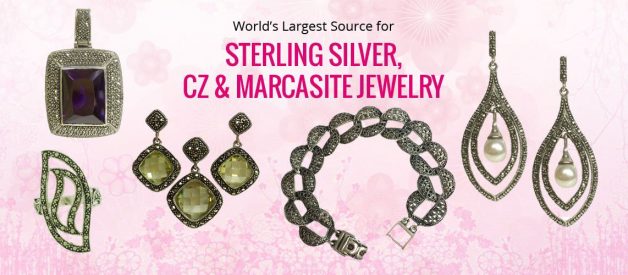 Sterling Silver Jewelry
Sterling Silver Jewelry
Silver is one of the most valuable metals and its use goes back to before 4000 BC. The value of silver in ancient times made it one of the most traded items and owning pieces of this precious metals was synonymous with wealth. The popularity of silver in jewelry making and other applications saw it spread across the world. Today silverware and jewelry remain popular in the fashion world.
If you are on the market for silver jewelry, you will come across two related materials; pure silver and sterling silver. If this is your first time buying silver jewelry, the two distinct materials might confuse you and it is important to distinguish them before hitting the stores. This guide delves into the differences between sterling silver and pure silver to help you make an informed choice when shopping for silver jewelry.
Overview of Pure Silver
Pure silver contains actual silver content of 99.9% and 0.1% trace elements. The first silver mines were around 4000 BC located in Anatolia which is in modern-day Turkey. Evidence of silver mining also exists in India, China, and Japan. The Greek, Romans, and Ancient Phoenicians had also discovered the amazing qualities of silver including its beauty and versatility leading to large scale mining in the early ages.
Pure silver is a bright natural material which has always been part of society since the early ages. It forms from sulfur compounds in the earth?s crust where temperatures are very high. A lot of silver metal used in jewelry making is a byproduct of copper, gold, lead, and zinc refining.
Among the notable qualities of this precious metal are extreme softness, malleability, and ductility. The metal boasts a brilliant white metallic luster which makes it perfect for decorative items such as jewelry and other artistic creations. The material also has a high electrical and thermal conductivity.
While pure silver is a bright and brilliant metal wise appearance makes it perfect for jewelry and other decorative items, it is too soft and this creates a big problem. Molding silver into intricate shapes to create durable items is difficult and this makes it unsuitable for commercial jewelry manufacture.
Overview of Sterling Silver
To overcome the challenge of working with soft pure silver, metal experts create an alloy of silver using 92.5% pure silver and 7.5% harder metal such as copper, nickel or zinc. The compound created is harder and more durable making it ideal for different applications such as jewelry making, utensils, like forks, spoons, coffee sets, and knives, If you are in search of silver jewelry, what you will find on the market is sterling silver jewelry.
The sterling silver alloy originated in continental Europe and its used dates as far back as the 12t century. There are artifacts of important sterling silver coins during the reign of Henry II and back the alloy was subject to official assay. Today, sterling silver retains its importance in jewelry making and you can buy a wide array of beautiful items on the market.
The compound retains the aesthetic qualities of pure silver including its brightness and brilliance with the added metal providing the strength required to use the material in different artistry works. Some of the qualities that make sterling a precious metal include the highly lustrous finish and versatile applications.
It is easy to work with this metal to form all shapes and this makes it an artisan?s dream material for jewelry making. If you are in the market for wholesale sterling silver jewelry, you can find pieces in all styles and designs.
The Difference between Sterling Silver and Pure Silver When shopping for silver jewelry, it is important to appreciate the differences between these two main silver types. To get started, take a look at the following distinguishing factors of sterling and pure silver:
- Composition: Pure silver contains 99.9% natural silver and 0.1% trace elements. There is nothing added to the metal after refining in the factory. On the other hand, sterling silver is an alloy of silver (92.5%) and another hard metal (7.5%) such as copper, zinc or nickel.2. Softness: Pure silver is very soft and for this reason, you will not find it used in making fine items such as jewelry. Artisans find it hard to work with this material and this is where sterling silver comes in handy. Sterling silver contains a metal which makes it harder and better to with for jewelry making.3. Tarnishing: Pure silver doesn?t tarnish because there is no metal added but sterling silver tarnishes over time. Copper is the most common added to pure silver to create sterling silver, and after exposure, it gets discolored which affects the surface of the item made using sterling silver. 4. Durability: The main reason for adding copper and other metal into pure silver is to strengthen it and toughen it making it ideal for use in long-lasting jewelry and other household items. 5. Identification: Sterling silver comes with a hallmark to identify it as genuine, but for pure silver, this is not necessary. Such hallmarks range from 92.5, 925, STER, 925 Sterling Silver, 925 Silver, STG or SS among other similar variations. 6. Cost: Pure silver is very expensive because it contains no additions but sterling silver is affordable and this makes it ideal for making jewelry and other household items.7. Value: Due to the inclusion of other metals such as copper, sterling silver has a lower value than pure silver. However, it is still beautiful and many jewelry lovers use it as an alternative veto more expensive metals such as white gold and platinum. 8. Versatility: Sterling silver is a versatile material which artisans can shape into intricate designs. This also makes it the best choice for many other items including flatware, accents, cutlery, surgical equipment, flutes and saxophones among other items.9. Skin reactions: With pure silver, there is no expected skin reaction as silver is hypoallergenic. For sterling silver, such problems can arise if the metal added is nickel. Some people are allergic to nickel and this causes problems when they wear sterling silver jewelry which includes this metal.
If you are in the market for wholesale sterling silver jewelry, now you have enough information to help you make the right choice. With this knowledge, you can avoid fakes on the market and assess any sterling jewelry you find more critically.


